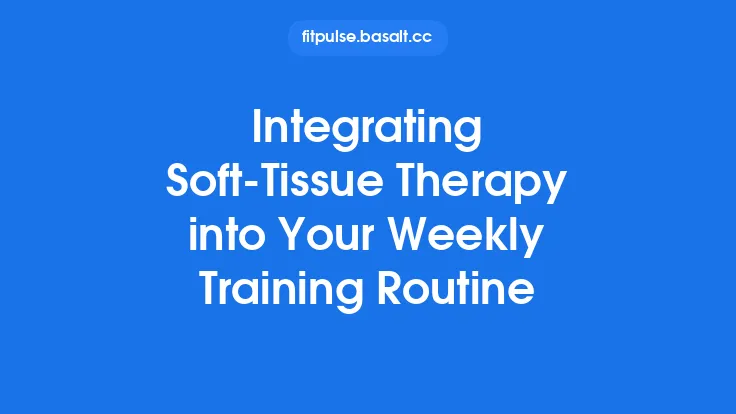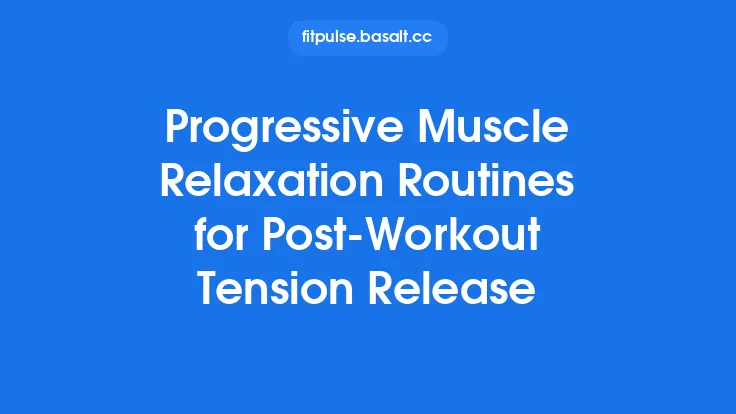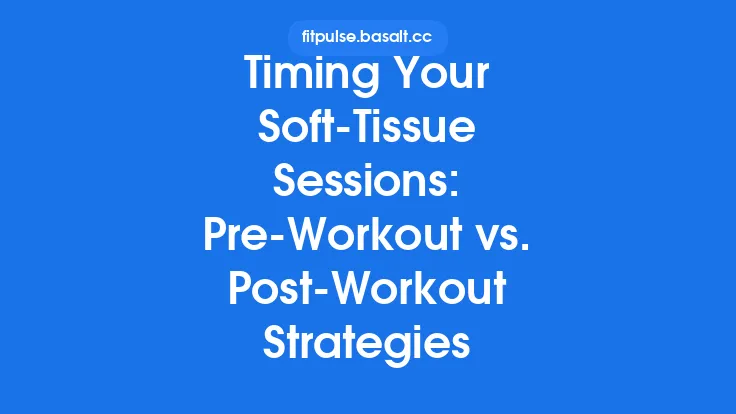After a demanding training session, the body is primed for recovery. While stretching, nutrition, and sleep are often highlighted, the simple act of alternating hot and cold water—known as a contrast shower—offers a practical, low‑cost way to accelerate the transition from exertion to restoration. By thoughtfully weaving contrast showers into your post‑workout routine, you can create a consistent habit that supports circulation, reduces perceived soreness, and prepares you for the next training block.
Why Contrast Showers Belong in a Post‑Workout Routine
Contrast showers are more than a novelty; they provide a structured stimulus that complements the physiological processes already set in motion by exercise. When you finish a workout, blood vessels in the working muscles are dilated, and metabolic waste products such as lactate begin to accumulate. Introducing alternating temperatures creates a rhythmic vasomotor response:
- Cold exposure triggers brief vasoconstriction, which can help limit the immediate pooling of blood in fatigued tissues and may assist in flushing out metabolites when the vessels re‑dilate.
- Heat exposure follows with vasodilation, encouraging fresh, oxygen‑rich blood to flood the muscles, delivering nutrients and facilitating the removal of waste.
The back‑and‑forth pattern essentially “pumps” the circulatory system, promoting a more efficient exchange of fluids and gases. Over time, regular use can improve the body’s ability to regulate temperature and blood flow, both of which are valuable for athletes who train frequently.
Designing a Structured Contrast Shower Protocol
A well‑crafted protocol balances simplicity with effectiveness. Below is a step‑by‑step template that can be customized to individual preferences and training demands.
| Phase | Temperature | Duration | Rationale |
|---|---|---|---|
| 1. Warm‑up | Warm (38‑40 °C / 100‑104 °F) | 2–3 min | Begins the recovery cascade with gentle vasodilation, easing the transition from intense activity. |
| 2. Cold Burst | Cold (10‑15 °C / 50‑59 °F) | 30 s – 1 min | Initiates vasoconstriction, briefly “shocks” the system, and stimulates the sympathetic response. |
| 3. Warm Return | Warm (38‑40 °C) | 2 min | Re‑opens the vessels, allowing fresh blood to enter the muscles. |
| 4. Cold Burst | Cold (10‑15 °C) | 30 s – 1 min | Reinforces the circulatory pump and adds a second sympathetic stimulus. |
| 5. Cool‑down | Tepid (30‑33 °C / 86‑91 °F) | 1–2 min | Gradually normalizes skin temperature and heart rate, preventing abrupt shifts. |
Key points to consider
- Number of cycles: Two to three cycles are sufficient for most recreational athletes. Elite performers may experiment with four, but diminishing returns often appear beyond the third cycle.
- Transition time: Move swiftly between phases; lingering in the hallway or waiting for the water to change temperature reduces the intended vascular “pump” effect.
- Water flow: A steady, moderate stream is ideal. A high‑pressure jet can be uncomfortable during the cold phases and may cause unnecessary stress on the skin.
Timing and Frequency: When and How Often
Immediate post‑workout vs. delayed implementation
The most common practice is to begin the contrast shower within 10–15 minutes after training, while the muscles are still warm and metabolic activity is elevated. This timing maximizes the circulatory benefits because the vessels are already primed for dilation.
Session frequency
For most athletes, incorporating contrast showers 2–3 times per week strikes a balance between stimulus and recovery. On days with particularly high training loads (e.g., double‑session days), a post‑session contrast shower can be paired with a lighter, morning contrast routine to aid overall recovery.
Duration across the week
A weekly “recovery block” might look like:
| Day | Activity |
|---|---|
| Monday | Standard post‑workout contrast shower (2 cycles) |
| Tuesday | Light active recovery (e.g., mobility work) – no contrast shower |
| Wednesday | Post‑workout contrast shower (3 cycles) |
| Thursday | Rest or low‑intensity cardio – optional brief contrast shower |
| Friday | Post‑workout contrast shower (2 cycles) |
| Saturday | Full rest – no contrast shower |
| Sunday | Optional morning contrast shower for general circulation |
Adjust the schedule based on how your body feels, training intensity, and any external stressors (travel, sleep disruption, etc.).
Integrating with Nutrition and Hydration Strategies
Contrast showers influence fluid balance through sweating (during the warm phases) and vasoconstriction (during the cold phases). To avoid inadvertent dehydration:
- Pre‑shower hydration: Consume 200–300 ml of water or an electrolyte‑rich beverage within 30 minutes before the shower, especially if the warm phase induces noticeable sweating.
- Post‑shower refuel: Follow the shower with a protein‑carbohydrate blend (e.g., 20 g protein + 40 g carbs) within 30 minutes to capitalize on the increased blood flow for nutrient delivery.
- Electrolyte monitoring: If you notice persistent cramping or fatigue, consider adding a modest amount of sodium (200–300 mg) to your post‑shower drink.
Combining Contrast Showers with Other Recovery Tools
Contrast showers can be part of a broader recovery toolbox. Here are a few synergistic pairings that avoid redundancy with the neighboring articles:
| Recovery Tool | How It Complements Contrast Showers |
|---|---|
| Foam Rolling | Mechanical release of myofascial tension before the warm phase can enhance blood flow when the heat is applied. |
| Compression Garments | Wearing compression for 30 minutes after the shower can sustain the vascular benefits by maintaining external pressure. |
| Gentle Yoga or Stretching | Performing a short mobility sequence after the cool‑down phase leverages the relaxed state of the muscles for deeper stretch. |
| Sleep Hygiene | The calming effect of the final tepid phase can aid in lowering heart rate, making it easier to transition into restful sleep. |
When layering modalities, keep the total recovery time reasonable (30–45 minutes) to prevent over‑loading the nervous system.
Monitoring Progress and Adjusting the Routine
Because individual responses vary, tracking subjective and objective markers helps fine‑tune the protocol.
- Subjective scales: Rate perceived muscle soreness (0–10) and overall recovery feeling before and after the shower. A consistent drop of 1–2 points suggests effectiveness.
- Performance metrics: Note any changes in subsequent training sessions—e.g., improved jump height, faster sprint times, or reduced fatigue.
- Physiological cues: Monitor resting heart rate and sleep quality. A stable or slightly lower resting heart rate over weeks can indicate improved autonomic balance.
If you observe no change after 3–4 weeks, consider adjusting one variable at a time: increase the number of cycles, modify temperature ranges, or shift the timing relative to the workout.
Safety Considerations and Contraindications
While contrast showers are generally safe, certain conditions warrant caution:
- Cardiovascular concerns: Individuals with uncontrolled hypertension, arrhythmias, or recent cardiac events should consult a healthcare professional before using rapid temperature changes.
- Neuropathy or skin conditions: Reduced sensation can increase the risk of burns or frostbite. Use milder temperature differentials and limit cold exposure to 30 seconds.
- Respiratory issues: Sudden cold exposure can trigger bronchoconstriction in susceptible individuals (e.g., asthma). A gradual temperature drop rather than an abrupt plunge can mitigate this.
- Pregnancy: Warm phases should stay below 38 °C (100 °F) to avoid excessive core temperature elevation.
Always listen to your body—if you feel dizzy, excessively shivery, or experience sharp pain, terminate the session and warm up gradually.
Practical Tips for Home and Gym Environments
- Temperature control: Use a handheld thermometer or a smart shower system to verify water temperatures, especially for the cold phase.
- Pre‑set timers: A simple kitchen timer or a phone app can keep each phase on track, preventing over‑extension of the cold burst.
- Footwear: Wear slip‑resistant sandals during the cold phase to reduce the risk of slipping on a wet floor.
- Water conservation: Collect the warm water in a bucket for later use (e.g., watering plants) to make the routine more eco‑friendly.
- Mindful breathing: Pair the cold burst with controlled, slow breaths (4‑2‑4 pattern) to help manage the sympathetic surge and maintain composure.
Future Directions and Personal Experimentation
Contrast showers sit at the intersection of tradition and emerging recovery science. As wearable technology becomes more accessible, athletes can now track skin temperature, heart rate variability, and even micro‑circulatory changes in real time. Experimenting with data‑driven adjustments—such as aligning the shower’s temperature swing with peaks in heart rate variability—may unlock personalized protocols that outperform generic guidelines.
For those inclined to explore further, consider:
- Variable temperature gradients: Instead of a fixed cold temperature, gradually lower the water temperature across cycles to create a smoother transition.
- Integration with mental training: Use the final tepid phase as a cue for a brief mindfulness or visualization exercise, reinforcing the mind‑body connection.
- Seasonal adaptations: In colder climates, start with a slightly warmer warm phase to avoid excessive core temperature drops; in hot climates, keep the warm phase shorter.
By treating contrast showers as a flexible, evolving component of your recovery arsenal, you can maintain relevance across training cycles, competition phases, and lifestyle changes.
Incorporating contrast showers into your post‑workout routine offers a pragmatic, evidence‑informed method to enhance circulation, modulate soreness, and support overall recovery. With a clear protocol, mindful timing, and attention to safety, this simple practice can become a cornerstone of sustainable athletic performance.





